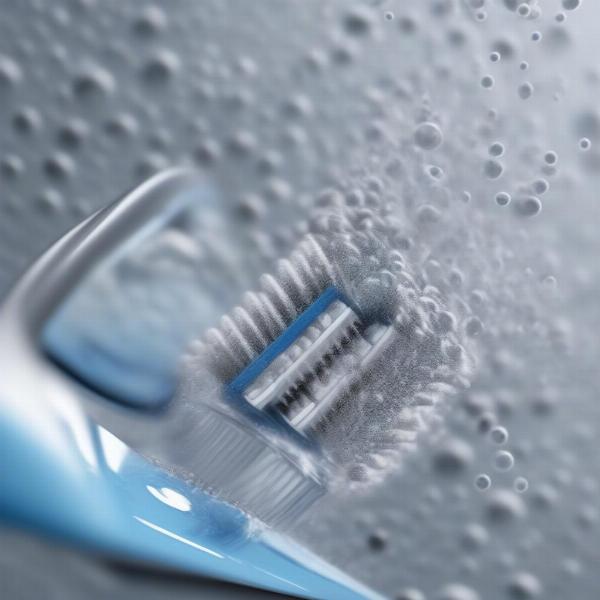Ultrasonic dog toothbrushes are gaining popularity as a convenient and effective way to improve canine dental hygiene. But with so many options on the market, understanding what they are, how they work, and how to choose the right one for your furry friend can be overwhelming. This guide provides a deep dive into the world of ultrasonic dog toothbrushes, offering valuable insights into their benefits, drawbacks, and practical usage tips.
Understanding Ultrasonic Dog Toothbrushes
Ultrasonic toothbrushes for dogs operate on a different principle than conventional brushes. Instead of relying solely on mechanical brushing, they utilize high-frequency vibrations to disrupt plaque and tartar buildup. These vibrations create tiny bubbles that implode, generating a cleaning action that reaches below the gum line and between teeth, areas often missed by traditional brushing.  Ultrasonic Dog Toothbrush Vibrations
Ultrasonic Dog Toothbrush Vibrations
Benefits of Using an Ultrasonic Dog Toothbrush
- Superior Plaque and Tartar Removal: The high-frequency vibrations effectively break down plaque and tartar, reducing the risk of periodontal disease.
- Reaches Hard-to-Reach Areas: The ultrasonic action cleans below the gum line and between teeth, providing more comprehensive cleaning than manual brushing.
- Less Abrasive: Ultrasonic toothbrushes are generally gentler on tooth enamel than traditional brushes, minimizing the risk of scratches and damage. dog sonic toothbrush
- Fresher Breath: By targeting the bacteria that cause bad breath, these toothbrushes help improve your dog’s oral hygiene and overall freshness.
Potential Drawbacks
- Noise Sensitivity: Some dogs may be sensitive to the high-pitched noise emitted by the toothbrush. ultrasonic dog teeth cleaner
- Cost: Ultrasonic toothbrushes are typically more expensive than conventional dog toothbrushes.
- Requires Training and Patience: Acclimating your dog to the new sensation may take time and patience.
Choosing the Right Ultrasonic Dog Toothbrush
With various models available, selecting the right ultrasonic dog toothbrush requires careful consideration. Look for features such as:
- Size and Shape: Choose a brush head that is appropriately sized for your dog’s mouth and tooth shape.
- Bristle Softness: Opt for soft bristles to avoid irritating your dog’s gums.
- Noise Level: If your dog is noise-sensitive, look for a model with a quieter motor.
- Battery Life and Charging Options: Consider the convenience of battery life and charging methods.
- Additional Features: Some models offer features like timers, multiple vibration modes, and even LED lights.
How to Use an Ultrasonic Dog Toothbrush
Introducing your dog to an ultrasonic toothbrush should be a gradual process. Start by letting your dog sniff and lick the toothbrush. Then, gradually introduce the vibrating brush to their mouth, starting with short sessions and gradually increasing the duration. dog teeth cleaner Reward your dog with treats and praise to create a positive association with brushing. “Start slowly and use positive reinforcement,” advises Dr. Emily Carter, DVM, a veterinary dentist based in London. “This will make the experience more pleasant for both you and your canine companion.”
Maintaining Your Ultrasonic Dog Toothbrush
Like any toothbrush, ultrasonic dog toothbrushes require regular cleaning and maintenance. Rinse the brush head thoroughly after each use and replace it every few months, or as recommended by the manufacturer. ultrasonic tooth cleaner for dogs Proper maintenance ensures optimal hygiene and prolongs the life of the toothbrush.
Conclusion
Ultrasonic dog toothbrushes offer a promising approach to enhancing canine dental health. While they might not replace regular veterinary check-ups and professional cleanings, they can significantly contribute to maintaining your dog’s oral hygiene and preventing dental problems. By understanding the benefits, drawbacks, and proper usage techniques, you can make an informed decision about incorporating an ultrasonic dog toothbrush into your dog’s dental care routine.
FAQ
- Are ultrasonic toothbrushes safe for dogs? Yes, when used correctly, ultrasonic toothbrushes are generally safe for dogs.
- How often should I use an ultrasonic toothbrush on my dog? Ideally, aim for daily brushing.
- Can I use human ultrasonic toothbrushes on my dog? No, it’s best to use a toothbrush specifically designed for dogs.
- What should I do if my dog doesn’t tolerate the ultrasonic toothbrush? Try a different model with a lower vibration setting or consult your veterinarian.
- Can ultrasonic toothbrushes cure existing dental disease? No, they can help prevent further buildup but won’t cure existing disease. ultrasonic dog teeth cleaning at home
- Do I still need to take my dog for professional dental cleanings? Yes, professional cleanings are still necessary for optimal dental health.
- Are there any specific breeds that benefit more from ultrasonic toothbrushes? Smaller breeds and brachycephalic breeds are often more prone to dental problems and may benefit greatly from these toothbrushes.
ILM Dog is a leading international online resource dedicated to providing expert advice on all aspects of dog care and wellbeing. From breed selection and puppy care to senior dog health and training, ILM Dog offers valuable insights and practical guidance for dog owners worldwide. We specialize in dog breeds, health, training, nutrition, grooming, and product reviews. For expert advice and personalized recommendations, contact us via email at [email protected] or phone at +44 20-3965-8624.